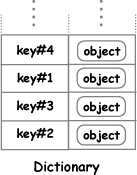Chapter 3. Structured Data: Working with Structured Data

Python’s list data structure is great, but it isn’t a data panacea.
When you have truly structured data (and using a list to store it may not be the best choice), Python comes to your rescue with its built-in dictionary. Out of the box, the dictionary lets you store and manipulate any collection of key/value pairs. We look long and hard at Python’s dictionary in this chapter, and—along the way—meet set and tuple, too. Together with the list (which we met in the previous chapter), the dictionary, set, and tuple data structures provide a set of built-in data tools that help to make Python and data a powerful combination.
A Dictionary Stores Key/Value Pairs
Unlike a list, which is a collection of related objects, the dictionary is used to hold a collection of key/value pairs, where each unique key has a value associated with it. The dictionary is often referred to as an associative array by computer scientists, and other programming languages often use other names for dictionary (such as map, hash, and table).

The key part of a Python dictionary is typically a string, whereas the associated value part can be any Python object.
Data that conforms to the dictionary model is easy to spot: there are two columns, with potentially multiple ...
Get Head First Python, 2nd Edition now with the O’Reilly learning platform.
O’Reilly members experience books, live events, courses curated by job role, and more from O’Reilly and nearly 200 top publishers.

